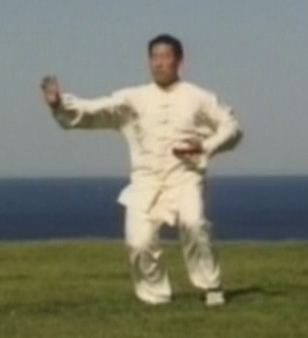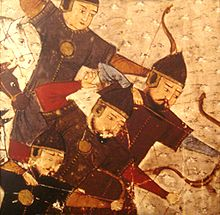
GM Chen Xiaowang |

Mongol soldiers6 |
Early in my practice of taijiquan I wondered where the names of the various postures and movements came from. There are some very interesting names - “Single Whip”, “Buddha's Warrior Attendant Pounds Mortar”, and “White Crane Flashes Wings”, among others. Many, if not most, seem to be descriptive. That is, they describe what the postures look like, even if only slightly. Over time, as taijiquan forms have been passed down through the generations, changes have taken place in the execution of the various postures as well as in the names by which they are known. Given the number of dialectal differences in spoken Chinese, it is not surprising to find posture names changing, even dramatically, over time.
One of the first posture names to pique my curiosity was the Chinese term Gao Tan Ma (高探马). Virtually all styles of taijiquan have this posture, usually translated to English as “High Pat on Horse”. In Chen Family taijiquan the posture Gao Tan Ma makes two appearances in Lao Jia Yi Lu (Old Frame First Set). Knowing a little Chinese, I was perplexed by the translation. The character gāo certainly means “high” or “tall”; mă is indisputably “horse”. The character tàn, however, does not seem to me to mean anything close to “pat” but rather “to explore”, “to scout”. So the term Gao Tan Ma should mean something like “Tall Scout Horse”. This interpretation is shared by long-time taijiquan player and writer, Lloyd Haft9. I have two questions about this posture name. In China, what was the perceived meaning of the term as it was passed down in the taijiquan tradition both oral and written? And, how did this term come to be translated as “High Pat on Horse”?
A search for “Gao Tan Ma” in Chinese martial and historical literature, both fiction and non-fiction, turns up few occurrences of the complete three-character phrase outside recent taijiquan texts. It does appear to be the case that the term is understood simply as a martial arts posture. It has this meaning as early as the 16th century when it appears in Chapter 31 of Journey to the West (also known as Monkey)1:“With both hands the Monkey King raised his staff and struck the 'Gao Tan Ma' posture”.
There are, however, several occurrences of tan ma in historical literature. It is defined in the Chinese language Modern Chinese Dictionary (现代汉语词典, 2004) as “mounted scout”. The entry notes that the term is seen mostly in early fiction. Indeed, the 14th century novels “Romance of the Three Kingdoms” and “Water Margin” both use the term tan ma as “scout” in describing military situations.
One of the earliest and most interesting occurrences of the term tan ma refers to a type of military unit of the Mongol state prior to and into the Yuan Dynasty when Genghis Khan conquered China in the 13th century. According to an entry on the Chinese website BaiDuBaiKe2, tan ma chi jun (探马赤军) was a crack vanguard and occupying military unit consisting of conscripts from all the various families and tribes. The terms tan ma chi jun and tan ma jun appear in the official Yuan history (Yuan Shi – 元史)3 where the method of conscription is described in detail. Chi means “scarlet”; jun means “army”. Tan ma chi also appears in the official Ming history4. The Mandarin term tan ma may actually have been a transliteration of the Mongol term for this army unit of 10,000 soldiers, tumen5. Of course ,a soldier in this crack army would likely have been an archer. One can easily see the form of the archer in the Chen style gao tan ma posture.

GM Chen Xiaowang |

Mongol soldiers6 |
So, when was the first occurrence of “High Pat on Horse” as an English translation of Gao Tan Ma? After considerable searching, I still cannot say. Michael Garofalo cites eight sources in Yang style taijiquan English literature for the term, all of them variations of “High Pat on Horse”. 7 The earliest use of the English term that I have been able to find is in H.C. Chao's Tai Chi Chuan, It's Effects and Practical Applications (1981).
Recently, some English translators have begun to use the “scout” meaning. A Wu style taijiquan web site uses “Scout On Horseback”.8 At this point, I'm inclined to think of Gao Tan Ma as some variation of this, perhaps “Tall Mounted Archer”. I realize, of course, that the name of the posture has little if any bearing on its correct execution. Just the same, I think the archer will now be my image of choice as I practice Gao Tan Ma.
John Warriner, 2012
1 武术的一种招数。《西游记》第三一回:“好 猴王 ,双手举棍,使一个‘高探马’的势子。”
2 http://baike.baidu.com/view/67175.htm
3 http://www.guoxue.com/shibu/24shi/yuanshi/yuas_098.htm
4 http://zh.wikisource.org/wiki/明史/卷129
5 http://en.wikipedia.org/wiki/Tumen
6 http://en.wikipedia.org/wiki/Mongol_military_tactics_and_organization
7 http://www.egreenway.com/taichichuan/short.htm#Sources
8 http://www.wu-taichi.com/html/wuenglish.html
9 http://lhaftblog.blogspot.com/2011/03/myth-of-tai-chi.html
Tucson Taiji Home Page